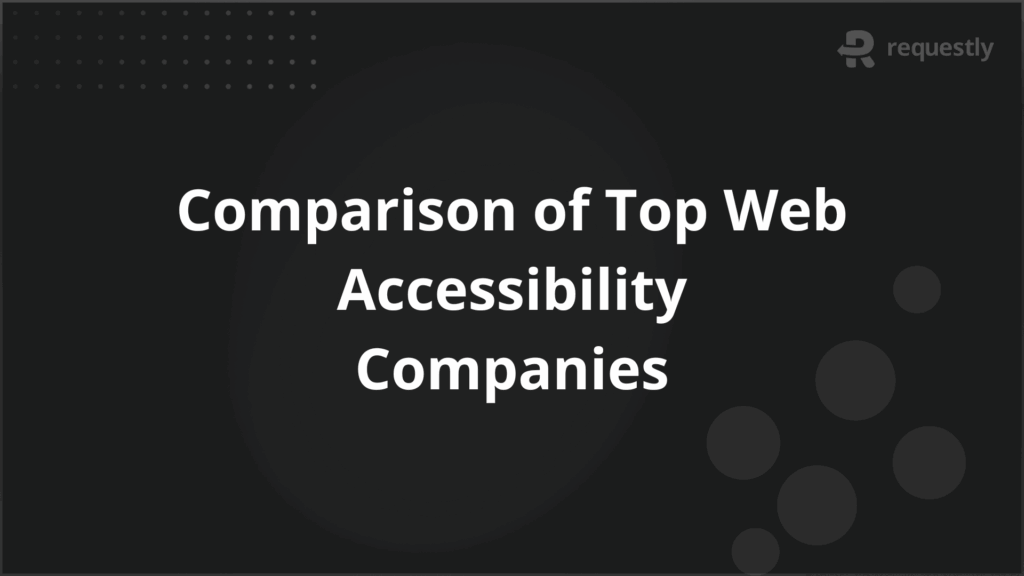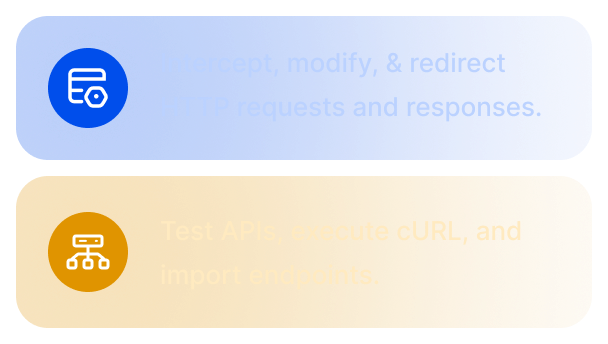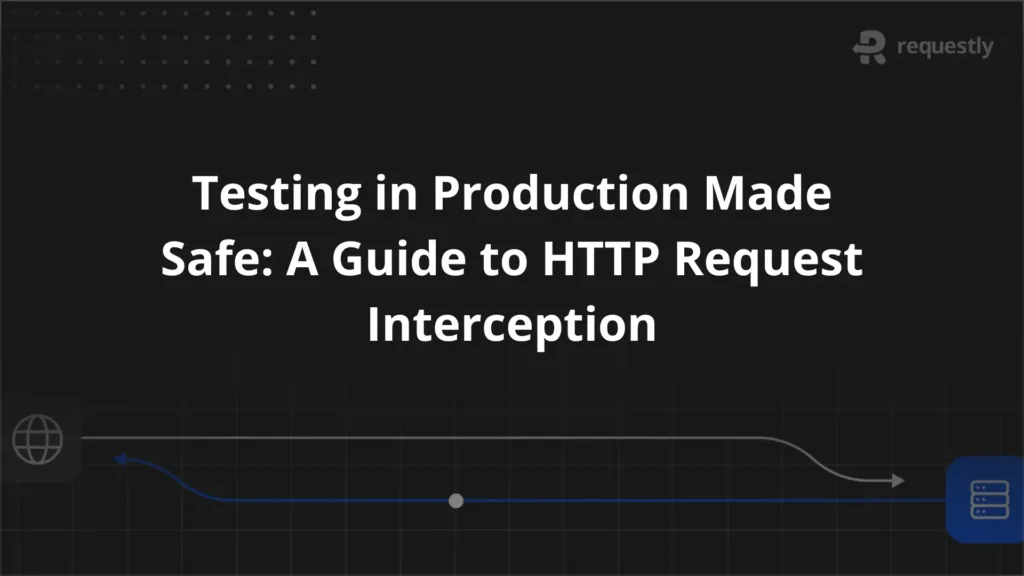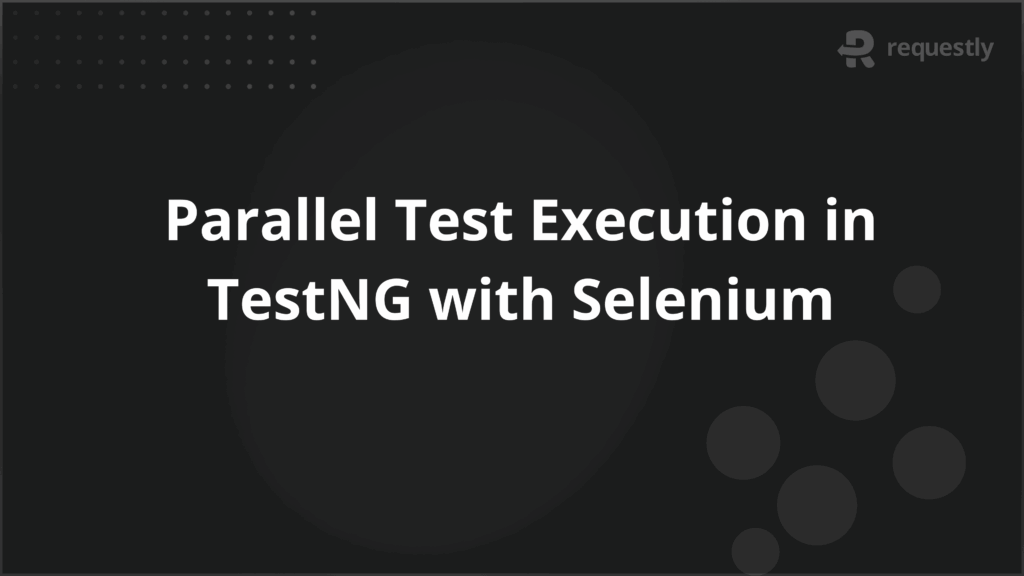Comparison of Top Web Accessibility Companies


Web accessibility is a critical component of inclusive digital experiences. As regulations such as WCAG, ADA, Section 508, and EN 301 549 gain global prominence, businesses are increasingly prioritizing accessibility compliance.
Web accessibility companies offer specialized tools and services to ensure that websites, apps, and digital documents are usable by people with diverse abilities, including those who rely on assistive technologies.
What is a Web Accessibility Company?
A web accessibility company specializes in creating, evaluating, and maintaining digital platforms that meet accessibility standards. These companies offer tools for automated testing, manual audits, remediation, policy guidance, and legal support.
Their goal is to help businesses achieve compliance with global accessibility laws and deliver a seamless user experience for all, including people with visual, auditory, motor, and cognitive impairments.
These organizations often maintain expertise in regulatory requirements, design patterns, assistive technology compatibility, and usability evaluation to meet comprehensive accessibility goals.
Why Businesses Need Accessibility Solutions?
Failing to meet accessibility standards can result in several risks and missed opportunities. Compliance goes beyond legal necessity and directly impacts user experience, brand trust, and market reach.
- Legal risks: Inaccessible websites can violate civil rights laws like the ADA in the U.S., leading to lawsuits, settlements, and public scrutiny. This risk is heightened for industries like finance, healthcare, and education.
- Lost audience: Over 1 billion people worldwide live with some form of disability. When digital platforms are inaccessible, they alienate a massive segment of potential users and customers.
- SEO and usability impact: Accessibility improvements often align with SEO best practices. Semantic HTML, ARIA attributes, and meaningful alt text enhance search visibility while improving navigation for all users.
- Brand reputation: Companies that prioritize inclusivity project a progressive and socially responsible image. Accessibility investments improve public perception, especially among government and enterprise partners.
- Operational efficiency: Identifying accessibility issues early in development avoids costly post-launch remediations and fosters scalable, sustainable design systems.
Categories of Web Accessibility Companies
Accessibility companies can be segmented based on their core offerings, delivery model, and technical orientation. Choosing the right category depends on internal capabilities, budget, and compliance urgency.
- Automated tool providers: These vendors offer web-based tools or APIs to conduct rapid scans of web pages. They detect errors against WCAG standards and suggest code-level fixes. Ideal for early detection and integration in CI/CD workflows.
- Manual audit and consulting firms: These specialize in human-led evaluations, using assistive tech, heuristics, and expert review. They offer depth and context where automated tools fall short.
- Hybrid platforms: Combine automated detection with manual verification and assistive tech testing. This ensures both speed and contextual accuracy and is suited for businesses seeking both compliance and usability improvements.
- Training and policy providers: Focus on knowledge enablement through courses, workshops, documentation, and policy frameworks. Critical for internal teams developing long-term accessibility strategies.
Compliance Standards and Legal Support
Meeting global accessibility regulations requires deep understanding of technical and legal standards. Accessibility companies support these through structured audits, documentation, remediation guidance, and legal alignment.
- WCAG 2.1/2.2: Developed by W3C, these are the most widely adopted technical standards. They categorize issues under Perceivable, Operable, Understandable, and Robust (POUR) principles. Companies help ensure A to AAA-level conformance.
- ADA Title III (U.S.): Mandates that places of public accommodation, including websites, be accessible to individuals with disabilities. Companies assist with risk audits and court-admissible documentation.
- Section 508 (U.S.): Applies to federal agencies and vendors, ensuring digital tools are accessible to government employees and the public.
- EN 301 549 (EU): Defines accessibility requirements for public sector ICT. Vendors support audits, language localization, and compliance workflows.
- AODA (Canada): Requires businesses and non-profits in Ontario to meet accessibility standards. Compliance services often include training, document tagging, and assistive device compatibility.
Vendors often provide VPATs (Voluntary Product Accessibility Templates), remediation roadmaps, and can serve as expert witnesses in accessibility-related litigation.
AI vs. Human-Led Approaches
Both AI-driven and human-led strategies serve distinct purposes within an accessibility compliance journey. Understanding the strengths and limits of each is essential.
- AI-led tools: Leverage rule engines and machine learning to run high-speed scans. They can identify issues like missing alt text, color contrast errors, keyboard trap detection, and heading structure flaws. However, they struggle with dynamic content, context interpretation, and screen reader usability.
- Human-led methods: Involve real accessibility professionals who evaluate experience through assistive technologies. These evaluations detect issues such as confusing focus order, improper ARIA implementation, and cognitive load challenges.
- Hybrid approach: The most effective strategies combine automation for breadth and frequency, with human audits for depth and context. This ensures accurate issue detection and real-world usability validation.
Considering Pricing Models & Engagement Types
Organizations need to understand pricing structures to make cost-effective and scalable decisions. Web Accessibility companies often offer different engagement models.
Subscription vs. one-time fees
- Subscription-based plans are suited for continuously evolving websites. They provide regular scans, monitoring, updates, and issue tracking to maintain ongoing compliance.
- One-time engagements are often used for compliance assessments, design reviews, or audits of static or rarely updated content.
Platform licenses vs. consulting services
- Platform licenses offer self-service dashboards, automated testing tools, and team collaboration features. They’re ideal for teams that want to own the remediation process.
- Consulting services involve deeper engagement—manual audits, hands-on remediation, legal consultation, and stakeholder training. These services support more strategic or high-risk environments.
Some vendors offer hybrid packages combining both approaches, allowing flexibility as organizational needs evolve.
Top Web Accessibility Companies
Here is a list of top web accessibility companies to consider:
1. BrowserStack Accessibility
BrowserStack Accessibility is part of BrowserStack’s broader testing ecosystem, designed to help QA and dev teams seamlessly include accessibility checks in their workflows. It offers real-device testing with assistive technologies, automated scans, and guided audits.
Services Offered:
- Automated WCAG and ADA scanning
- Assisted testing workflows for teams
- Manual testing on real devices with NVDA, VoiceOver, TalkBack
- CI/CD integration via BrowserStack Automate
- Scheduled scans and historical issue tracking
Pricing:
- Sold as a modular add-on to BrowserStack plans
- Custom enterprise pricing based on domains and scan frequency
Key Features:
- Unified test infrastructure (functional, visual, and accessibility)
- Real-world assistive technology validation
- Dashboard for tracking issue history and compliance progress
- Developer-first integrations for shift-left testing
Pros:
- Complete testing ecosystem in one platform
- High test accuracy through live assistive tools
- Supports modern CI/CD workflows
Cons:
- Requires broader BrowserStack subscription
2. EqualWeb
EqualWeb is a hybrid provider offering AI-based overlays alongside manual audits, remediation, and compliance certifications. It’s designed to serve both SMBs looking for quick fixes and enterprises needing deep audits.
Services Offered:
- Accessibility overlay widget
- Full WCAG 2.1 audits and reports
- Manual remediation, document tagging, screen reader testing
- Accessibility certification and statement support
- PDF accessibility and mobile app coverage
Pricing:
- Overlay starts at $39/month for small sites
- Enterprise plans include auditing and consulting
Key Features:
- On-site widget with keyboard nav, contrast modes, and more
- Visual issue dashboard with analytics
- AI and human-led audits
- Includes legal documentation support
Pros:
- Fast initial deployment
- Covers a wide range of accessibility needs
- Affordable for small businesses
Cons:
- Overlay can fall short of full compliance without manual audits
- Manual services cost extra
3. Level Access
Level Access provides enterprise-grade accessibility services and software tailored for compliance at scale. It combines digital tools, training, audits, and legal consulting for organizations in regulated industries.
Services Offered:
- Web and mobile accessibility audits
- Policy creation, VPAT documentation, and compliance reports
- Accessibility training and awareness programs
- Platform tools for managing accessibility across teams
- Ongoing compliance monitoring
Pricing:
- Custom pricing for large organizations
- Typically includes software license plus consulting services
Key Features:
- Comprehensive support across development, QA, and legal functions
- Workflow integrations with issue tracking tools
- Custom training and audit cycles
- Certification documentation and litigation support
Pros:
- Trusted by large institutions and government agencies
- Deep legal and strategic support
- Long-term scalability
Cons:
- Too complex and expensive for small teams
- Longer onboarding cycle
4. Oswald Labs (Agastya)
Oswald Labs is a social innovation startup focused on inclusive digital technologies. Its flagship product, Agastya, is an accessibility enhancement plugin that empowers websites with user-adjustable features for people with cognitive, visual, and motor impairments.
Rather than targeting legal compliance alone, Oswald Labs emphasizes usability and personalization, particularly for users with dyslexia, ADHD, color blindness, and low vision.
Services Offered:
- JavaScript-based Agastya toolbar integration for accessibility controls
- Cognitive accessibility enhancements including dyslexia-friendly font, reading rulers, and adjustable line height
- Visual aid features like contrast toggles, grayscale mode, text zoom, and negative color filters
- Text-to-speech functionality with support for multiple languages
- Real-time auto alt-text generation using AI-based computer vision
- Screen reader mode simulation and simplified content views
- Mobile SDK for accessibility features within native apps
Pricing:
- Free plan available for websites with fewer than 10,000 monthly pageviews
- Paid plans are tiered based on monthly usage and level of customization
- Enterprise packages offer custom styling, analytics, and on-premise deployment
Key Features:
- Fully customizable user-facing toolbar that supports 15+ accessibility settings
- Lightweight, plug-and-play implementation with minimal code
- Multilingual support and integration with machine translation APIs
- Accessibility analytics dashboard for tracking user interactions
- Optimized for low-bandwidth environments and mobile-first deployments
Pros:
- Highly effective for cognitive and user-centered accessibility
- Zero-code deployment makes it accessible to non-technical teams
- Free tier and affordable pricing are ideal for small businesses and NGOs
- Adds immediate value without altering existing website structure
- Focus on personalization improves user retention and engagement
Cons:
- Does not provide formal WCAG audits or legal compliance documentation
- Lacks developer-oriented tooling or remediation guidance
- Not designed for regulated industries requiring structured certifications
- Limited integration with enterprise QA or CI/CD environments
Comparing Key Accessibility Providers
In choosing an accessibility partner, direct feature-by-feature comparisons can clarify fit based on priorities such as developer workflow integration, legal support, scalability, or user-friendliness. Here is a quick comparison table of top web accessibility companies:
Company | Tool Type | Manual Audit | Assistive Tech Testing | Developer Integration | Accessibility Standards Compliance | Real Devices for Testing | Best For |
BrowserStack | Hybrid Platform | Yes | Yes | CI/CD & test automation | WCAG 2.1, 2.2, ADA, Section 508, AODA,EN 301 549, etc | Full | Full acecssibility testing on real devices |
EqualWeb | Overlay + Manual | Yes | No | Moderate | WCAG 2.1, ADA, Section 508 | None | SMBs seeking fast deployment + audits |
Level Access | Full-Service Platform | Yes | Partial | Moderate | WCAG 2.1/2.2, ADA, Section 508, EN 301 549 | Limited | Enterprises and compliance-heavy orgs |
Oswald Labs | Accessibility Plugin | No | No | Low | WCAG (partial), UX enhancements | None | Startups and inclusive content publishers |
Tenon | Dev Tool + Consulting | Yes | No | Full API and CI integration | WCAG 2.1, Section 508 | None | Agile dev teams focused on code quality |
Common Mistakes When Selecting a Vendor
Choosing an accessibility vendor without understanding internal needs, compliance goals, and technical complexity can lead to ineffective implementation. Common pitfalls include:
- Relying solely on overlays: Overlays may improve perceived accessibility but don’t remediate underlying code-level issues, risking non-compliance.
- Ignoring manual reviews: Automated scans miss UX issues that affect real users. Without human validation, critical usability flaws may remain unresolved.
- Neglecting legal preparedness: Vendors without legal compliance knowledge may leave organizations vulnerable to litigation.
- Overlooking integration: A tool that doesn’t fit the team’s development process, CMS, or QA workflow will lead to inefficiencies.
- Short-term focus: One-off audits may resolve existing issues but won’t sustain accessibility as content and code evolve.
How to choose the Right Accessibility Partner?
Selecting the right vendor requires a multi-faceted evaluation aligned to business maturity, technical needs, and user demographics.
- Clarify objectives: Are you aiming for legal compliance, inclusive UX, or both?
- Evaluate technical integration: Does the tool support your codebase, frameworks, and pipeline?
- Demand proof of capability: Review sample audit reports, testing accuracy, and turnaround times.
- Assess service breadth: Vendors offering only automated tools may not scale to complex environments. Look for consulting, training, and documentation support.
- Prioritize accountability: Choose vendors with transparent remediation timelines, tracking, and SLA-based commitments.
- Pricing model: Choose the company that offers the best suited pricing model that aligns with your goals and budget.
Involve cross-functional stakeholders—developers, designers, legal, and content teams—to ensure alignment across accessibility workflows.
Accessibility Tools vs. Professional Services
Accessibility initiatives often blend technology with expert intervention. Understanding when to use which is critical.
- Tools like BrowserStack Accessibility, Lighthouse, etc are best for organizations with internal capacity to act on findings. They provide actionable dashboards, issue detection, and sometimes automatic remediation suggestions.
- Professional services are essential when technical knowledge or legal understanding is lacking. These services add value through manual audits, inclusive design validation, assistive tech testing, and user-centered research.
Relying on tools alone may leave important context gaps. Conversely, services without embedded technology may not scale. Mature accessibility programs use both to cover breadth and depth.
Future Trends in Web Accessibility
The field of accessibility is rapidly evolving in response to new technologies and regulations. Key trends include:
- AI-generated content validation: As generative AI tools proliferate, ensuring the accessibility of auto-generated pages and UI components is critical.
- Mobile-first and app accessibility: Progressive Web Apps and hybrid apps require deeper testing on mobile OSs and devices.
- Voice interaction and gesture control: Emerging interfaces demand accessibility beyond keyboard and screen reader compatibility.
- Regulatory expansion: Countries like India and Brazil are introducing stricter digital accessibility mandates, requiring broader compliance across regions.
- Inclusive UX design: Shifting from compliance-driven retrofitting to proactive inclusive design as part of product development lifecycles.
Building a Long-Term Accessibility Strategy
To sustain accessibility, organizations must move beyond audits to institutionalize inclusive practices.
- Define KPIs: Track accessibility coverage, fix turnaround time, and user feedback from assistive tech users.
- Upskill teams: Continuous training on WCAG standards, ARIA use, and assistive tech behavior is crucial for dev, design, and content teams.
- Embed into development: Ensure design systems and component libraries are accessible by default.
- Automate testing in pipelines: Integrate accessibility checks into Git workflows, CI/CD, and staging deployments.
- Establish governance: Assign ownership, set policies, and create escalation paths for accessibility concerns.
Vendors that offer tools, strategy, and customer support are valuable partners for building institutional accessibility maturity.
Final Thoughts
Web accessibility is a dynamic challenge that requires sustained attention, cross-team coordination, and continuous improvement. While tools accelerate detection and monitoring, only a combination of automation, human validation, and long-term strategy ensures legal compliance and user inclusivity.

Contents
- What is a Web Accessibility Company?
- Why Businesses Need Accessibility Solutions?
- Categories of Web Accessibility Companies
- Compliance Standards and Legal Support
- AI vs. Human-Led Approaches
- Considering Pricing Models & Engagement Types
- Subscription vs. one-time fees
- Platform licenses vs. consulting services
- Top Web Accessibility Companies
- 1. BrowserStack Accessibility
- 2. EqualWeb
- 3. Level Access
- 4. Oswald Labs (Agastya)
- Comparing Key Accessibility Providers
- Common Mistakes When Selecting a Vendor
- How to choose the Right Accessibility Partner?
- Accessibility Tools vs. Professional Services
- Future Trends in Web Accessibility
- Building a Long-Term Accessibility Strategy
- Final Thoughts
Subscribe for latest updates
Share this article
Related posts





















